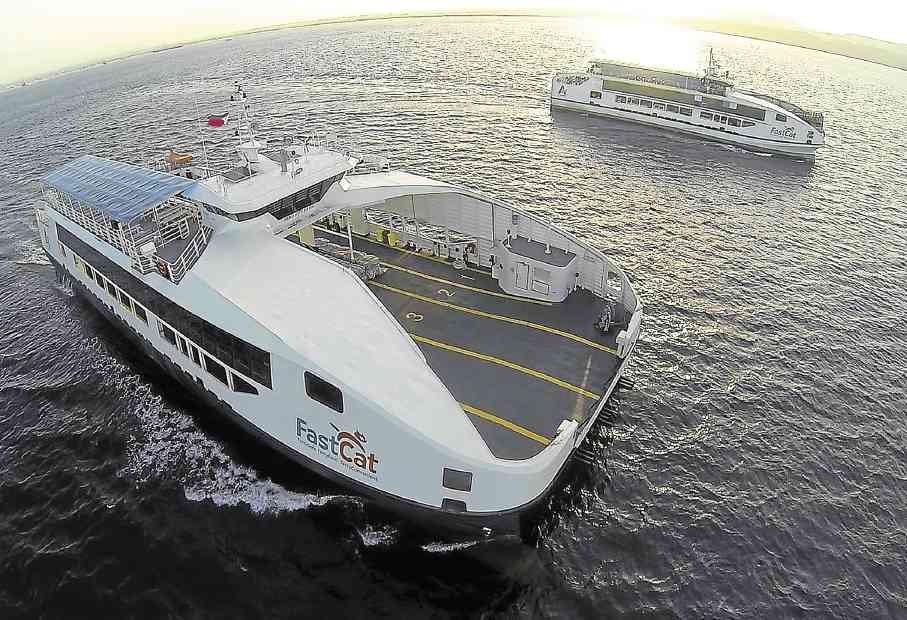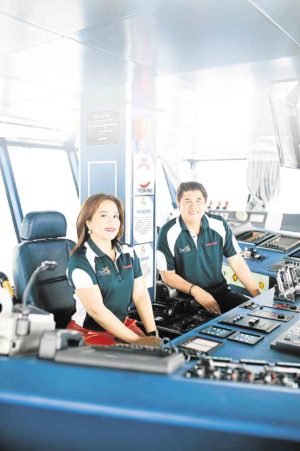FastCat spurs sea change in travel

FastCat’s vision is to provide passengers and businesses a seamless land and sea transport solution.
Not too long ago, and even in some cases now, inter-island travel by ferry in the country can be a horrible experience.
Suffocating fumes on very slow and old ferries, filthy restrooms both on the vessel and at the terminals, inadequate and uncomfortable seats and bunks, untrained and inattentive crew and a disorderly crowd are just some of the downers.
Christopher S. Pastrana says his wife, Mary Ann, got seriously ill after having that nightmarish experience years ago when they took a ferry on their way to visit his father in Calbayog City in Samar via Matnog, Sorsogon.
Interconnection
The couple loved to travel and they wanted to explore every island in the country. But the experience was just so bad that they couldn’t bear the thought of riding ferries again under the same circumstances.
“But in an archipelago like the Philippines, with its 7,107 islands and with many of those islands unreachable by land or air transport, traveling and transporting goods by sea seem unavoidable,” says Christopher.
Article continues after this advertisementChet and Ann, as they are fondly called by friends and associates, believe these islands should be interconnected for them, including the remotest areas, to prosper and for Filipinos to better understand each other.
Article continues after this advertisement“We are so divided as a nation because of the islands and our different dialects. With our ships, we can help bridge these gaps, we can help people connect and understand each other, help even the most remote areas grow,” says Ann.
They vowed to do something about it, so when the opportunity to do so came their way, they grabbed it.
Today, through Archipelago Philippine Ferries Corp. (APFC), which the couple and their partners own, Chet and Ann manage and operate FastCat—the youngest, most modern and professionally run fleet of roll-on roll-off (Ro-Ro) vessels in the country servicing destinations underserved or totally unserved by other means of transportation.
With a fleet of 10 brand new, double-hull catamarans, all purchased from Australia, FastCat provides not only fast, safe and convenient transport services to passengers, but also an efficient and economical solution to the shipping concerns of businesses in far flung areas, particularly the small ones.
They also operate and manage eight ports and terminals, mainly in areas where FastCat operates, to provide a complete service to their clients.
Going Asean
FastCat currently services nine routes in Southern Luzon, Visayas and Mindanao. The goal in the medium term is to cover 30 routes that will serve more inner islands of the Philippines and further expand its reach outside the Philippines by covering islands initially in Indonesia and Malaysia.
To do that, Chet says FastCat targets to beef up its fleet by another 20 vessels.
“The vision is to provide passengers and businesses a seamless land and sea transport solution,” Chet says, adding that this is being made possible through a partnership with the Philtranco and Jam Transit group that co-owns FastCat.
These bus companies provide the land transport services while FastCat takes care of the sea transport side of the package.
Beginning
The couple, who met during their college days at the University of the Philippines-Los Baños, were exposed to shipping and port operations in the 1980s when they were in the business of trading, particularly of goods like cement, fertilizers and glass products.
They used to charter vessels to deliver their products to clients.
The opportunity to operate their own fleet came in 2000, when a company Chet was affiliated with had to sell its cargo vessels and barges. That company had four old vessels and the Pastranas bought them, and that started their shipping venture.
A few years later, bus firm Philtranco offered to the couple its shipping unit so it could focus on its bus operations. The couple agreed, got some loans and purchased the ferry operations of Philtranco.
APFC was born.
The deal, Chet says, came with an agreement that Philtranco, then the only bus company with a franchise from Luzon to as far as Mindanao, would use APFC to service its Ro-Ro requirements provided the ferry fleet would be modernized and maintained well.
The Pastranas grew the fleet from four to nine vessels and operated it from 2002 to 2009. But they weren’t too happy about it as the fleet, made up of old single-hull vessels imported second-hand mainly from Norway and Japan, was too old. That did not help them fulfill their dreams of providing an ideal ferry service to passengers and an efficient transport solution to businesses.
“Also, we knew that in shipping, you either grow the business to have the scale and be able to provide a real seamless travel and connectivity, or big companies will eat you up,” Chet says. “We thought if airlines and even oil tankers are continuously modernizing, why should ferries be left behind? That’s when we started to talk to people, look for some investors who will invest in us and plan the modernization of our fleet.”
Philtranco and Jam Liner, which were then growing their respective fleets, offered to team up with the Pastranas and provided them with the fresh money they needed to modernize their fleet.
With the additional capital, Chet started his search for the type of vessels that were safe and would meet the peculiar requirements of interisland traveling in the Philippines –such as space not only for regular cargo but also for the requirement of this Filipino custom of buying and bringing pasalubong (presents) wherever they go—without compromising the comfort of the riding public.
“The double-hull catamarans made in Australia were a perfect fit. At that time, all our vessels were mono hull and we thought it was high time we had a catamaran. It is safe and stable because it has two hulls. I researched the history of catamaran and there was no loss of life on record . Many accidents happen because of human error but if given a much better option, the risks can be mitigated. Catamarans are also fuel efficient, they have good design and are spacious,” says Chet.
The Pastranas received their first Catamaran in 2013, when FastCat (for fast Catamaran) was born, and the rest is history. More vessels came and even more are coming in the next few years.
FastCat cuts the shipping time by at least half (the three-hour trip from Batangas-Calapan is now down to one and a half hours), it also provides comfortable, air-conditioned and clean facilities.
On the business side, traders save much more time transporting their goods from one island to another or from these islands to Manila and vice versa. Typically, these traders use containerized ships in delivering their products to Manila. But these ships do no leave port until they are full and this process, from Cebu to Manila, takes 12 to 14 days. With FastCat Ro-Ro, the process takes only 18 to 21 hours from Cebu to Manila and back and 28 to 31 hours from Mindanao. This is because FastCat takes in the cargo no matter how big or small they are.
With the partnership between FastCat and Philtranco, cargo can be delivered door-to-door anywhere in the Philippines. FastCat also helps boost tourism in many areas that are currently not on the radar of both local and foreign travelers.
It brings travelers to these destinations, helps local governments in those areas prepare themselves for visitors and FastCat vessels run videos on these destinations continuously for all their passengers to see.
One vessel
Chet and Ann are happy with the performance of the catamaran so they have decided to stick with it. This strategy also proved to work well with the business. “We believe having only one type of vessel is a good business model for a shipping company. Before, we were always in need of different types and sizes of engines and spare parts and we had to train our crew for different competencies. That means you have no control over your operating costs,” Chet says, “Today, we operate more efficiently because there is commonality in spare parts, instrumentation and in the training of our crew. Familiarity and redundancy are there.”
Professional service
To support the operations of FastCat and ensure the best possible service, and to help train future seafarers, the company regularly conducts training programs for its crew and students from seafaring schools.
For their career advancement, a mentoring program is conducted for members of the crew by master mariners who worked in international shipping companies.
“We are looking at ourselves as a transportation solution company. People are the main asset of the company. Without quality seafarers, you are doomed no matter how advanced your vessels are,” says Ann.
She says the company is helping make seafaring an attractive career option for the young people by raising the bar both in the quality of seafaring as a career and the seafarers themselves.
FastCat ensures a highly professional crew management system. Not only are they provided training and the best possible working conditions on the vessel, they also get a quality life off the vessels.
“No one sleeps in the vessel. Like their counterparts in the airlines, everyone gets off the vessel to rest and attend to their personal affairs after a maximum 12-hour duty,” according to Ann.
The crew members are provided living quarters on land for free and in one hub of FastCat, the Pastranas are building a hotel where crew members can stay.
The hotel will be equipped with the amenities that can be enjoyed by crew members, like a swimming pool and gym, and the plan is to provide them with laundry services.
“Our salary scale is 40 percent higher than those of other shipping companies in the Philippines. We want them to be proud of their profession and we want young people to see all these and aspire to be seafarers,” says Ann.
An apprenticeship system is also in place and open to those interested but lacking in resources. Students can take advantage of the officer and cadet scholarship program, on condition they will work with FastCat for a given period.
“We are doing all these things to show the world that we have modern, safe and comfortable vessels that can take people to various parts of the country and, soon, some islands in Malaysia and Indonesia. We are trying to show the local shipping industry itself that it can be done. We are still having birth pains and we know we still have a long way to go to achieve what we have envisioned for FastCat, but we are moving forward and we are getting there,” Chet and Ann say.

